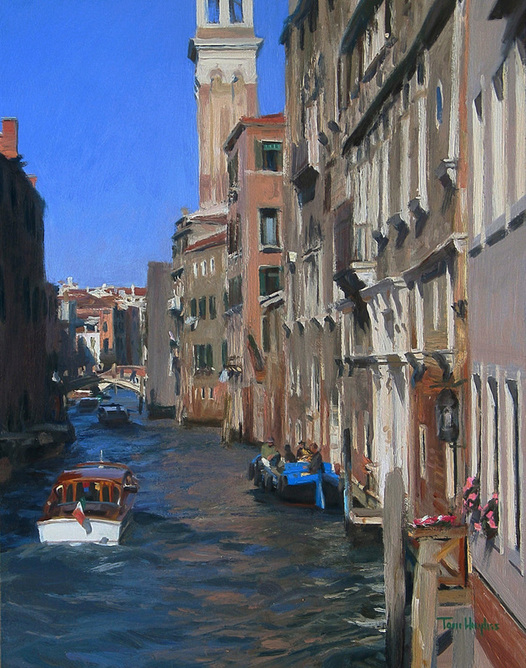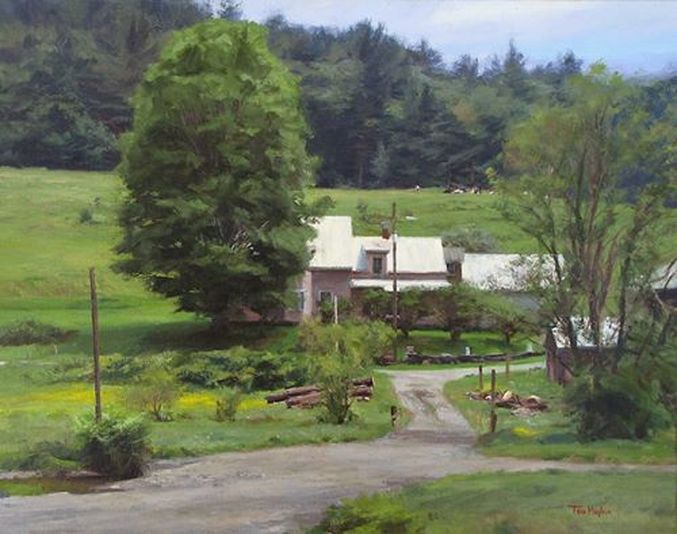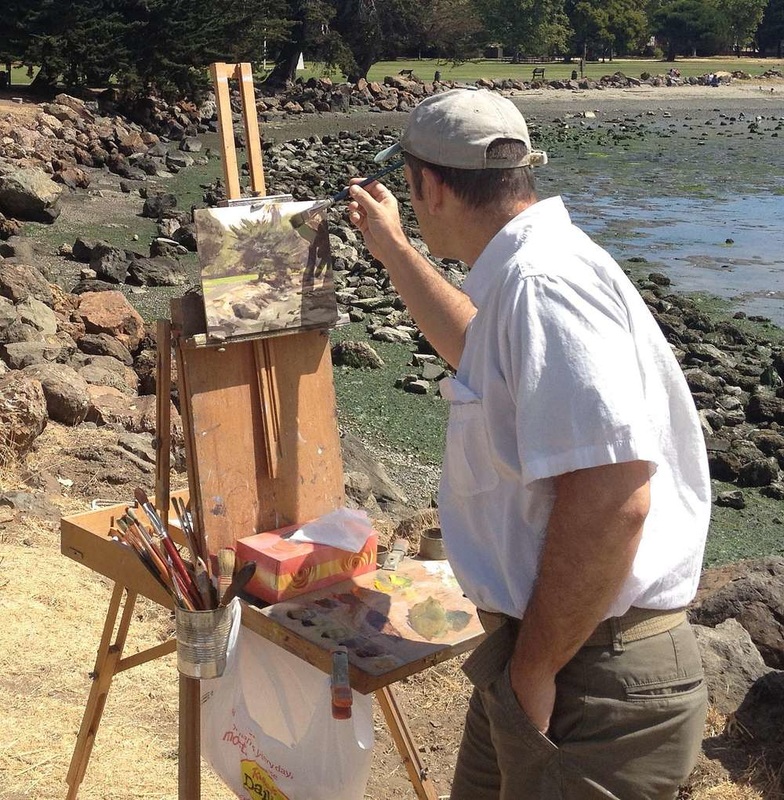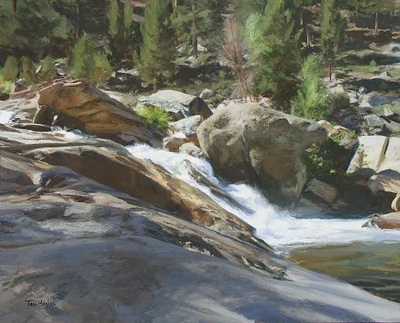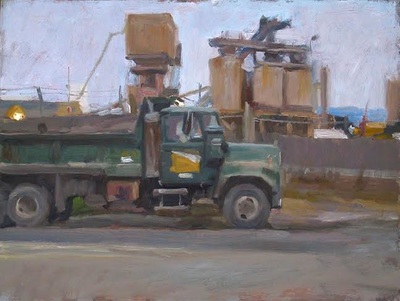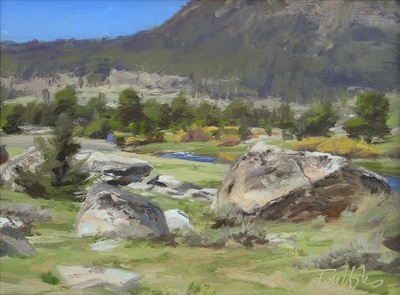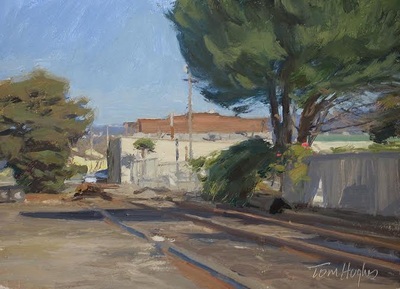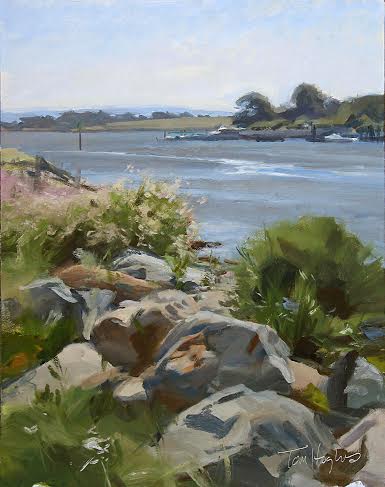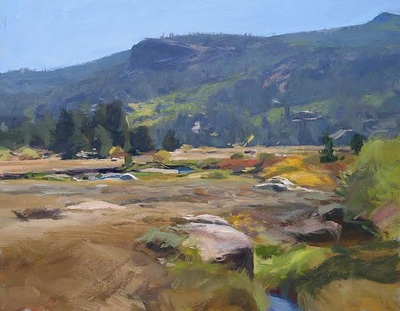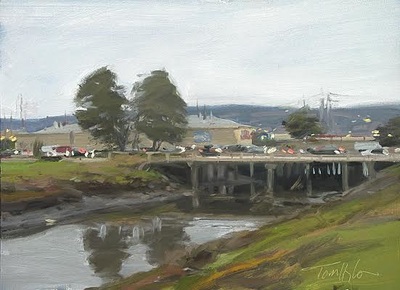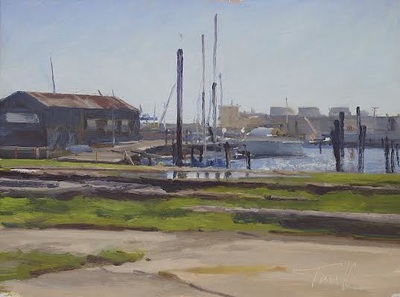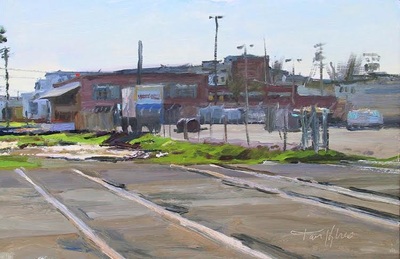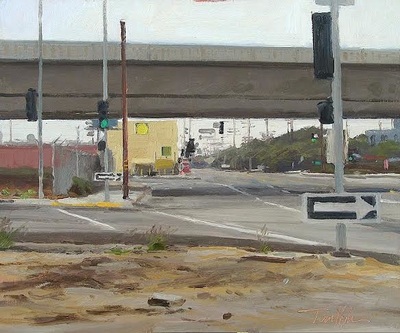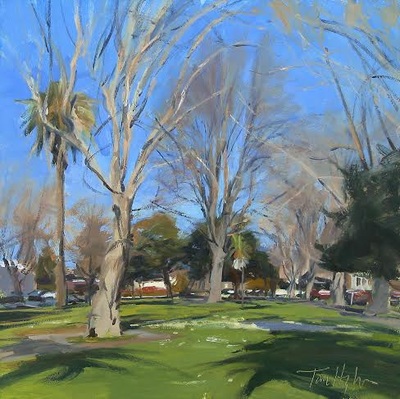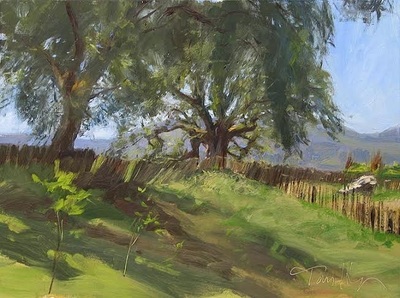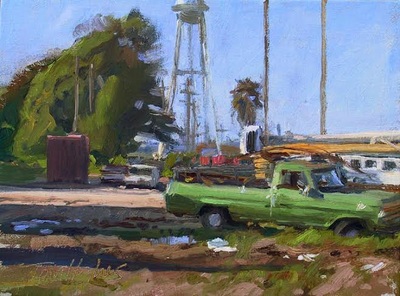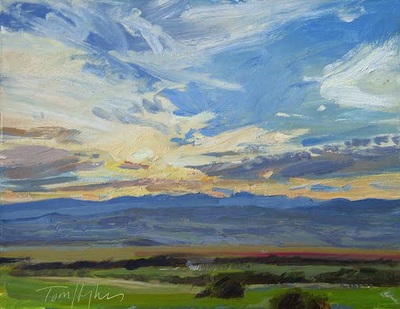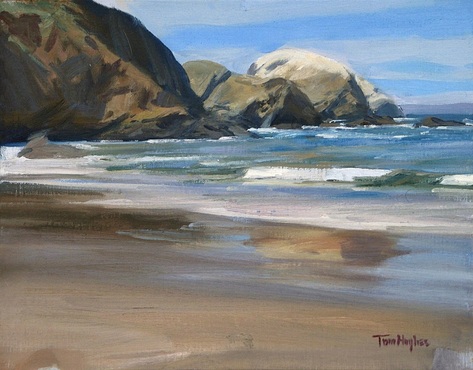 "Bluffs" oil on linen panel. (8x10") Plein air by Tom Hughes
"Bluffs" oil on linen panel. (8x10") Plein air by Tom Hughes
TOM HUGHES
3 Day Plein air painting workshop,
October 8-10, 2019 ($450)
Ogunquit, ME & Portsmouth, NH
(Limit 12) Call Todd to register (603) 819-9100
Email: [email protected]
Last years workshop filled and wait listed.
I am thrilled to announce an encore workshop of nationally recognized artist Tom Hughes to our 2019 workshop roster...We are lucky dogs to have him aboard for a three day workshop in October. I personally regard Tom to be one of the current heavy-weight champs of painterly realism in America. His work possesses that perfect balance between tight-and-loose...representational-and-expressive. He is a painters-painter, with a rare ability to balance incredible technical proficiency while maintaining a deep sense of feeling in the work. Tom is making Art. With seasonably pleasant outdoor painting weather and post-tourist traffic, October is one of the most beautiful times to be on the New England seacoast. This will be an amazing learning experience with a breathtaking coastal backdrop! To join us and register for this rare opportunity to study with a modern day master, call Todd (603) 819-9100 or email: [email protected]
From the studio of Tom Hughes:
These workshops are meant to be intensive hands-on learning experiences: they are a chance to build or reinforce skills and try new things without the pressure of having to make "finished" paintings that you have to sign. Have you always wanted to make painterly pictures with big fat brushstrokes but couldn't quite bring yourself to carry it through? Would you like to be able to draw a bit better, make things look their proper sizes, but can't always figure out why things don't look quite right? Maybe practice mixing colors from a limited palette? We can do any of these things -- I'm there to give you ideas, technical advice, moral support, demonstrations -- whatever insight I've accrued from more than 20 years of full-time painting.
My workshops are pretty informal and open to improvisation. We meet in the morning at the predetermined location, or somewhere convenient to it; lunch is bring-your-own. I do plenty of off-the-cuff individual demos or extended explanations, exhortations, etc, as needed. If everyone likes a particular spot, we'll stay there, and if not, we go. It's lots of painting and usually plenty of fun.
The day starts when we meet at the location at 9:00 am. I will do a demonstration painting on the first day until lunchtime, generally about noon. After that everyone picks a spot and starts painting. I work with attendees individually to help them bring about their own visions in their paintings. The following days incorporate more painting by workshoppers, sometimes on approaches or exercises that I assign. The workshop-day ends at 4 pm.
Supply List
Here is a list of the materials I usually use.
Materials: oil/acrylic
Easel for painting outdoors - examples include:
French easel - I use either one of these or a gloucester easel (particularly good for larger paintings). As far as I can tell, the best french easels currently generally available are made by Mabef.
Soltek easel - a variation on the french box easel; many of my workshop attendees use these.
Pochade box - very compact and convenient option for outdoor painting. Off the top of my head, brands include: Open Box M, EasyL, Guerrilla
A web search will display plenty of other outdoor easels.
Palette - most plein air easels come with a palette. I favor a wooden palette, or, for acrylic, a glass palette.
Rags, paper towels, or kleenex - for wiping brushes, general cleanup.
Something to paint on - stretched canvas, canvas board, primed masonite, primed paper, etc. Panels (masonite or mdf), either commercially prepared or prepared by the artist are what I prefer for smallish paintings. Preparations include: acrylic gesso application, an alkyd or oil ground, canvas glued to the panel. There are other preparations, but these will do fine. Commercially prepared panels are available at any art materials supplier.
Brushes - a selection of a few hog bristle brushes: chiefly a large bright (size 10 or higher), some rounds, filberts, flats - whatever you prefer. I use soft brushes as well, chiefly cheap synthetic watercolor rounds, though they are unnecessary for workshops.
Palette knife - you realize how important this is when you forget to pack it.
Paint thinner - I get what they call "odorless" mineral spirits from the hardware store. Art materials manufacturers make their own versions - touted to be safer, less toxic, etc - Gamsol and Turpenoid are popular varieties. ( If you get it from the hardware store, make sure it's not labelled "green" or "safer"- one of Kleen-Strip's thinners is labelled thus: it seems to contain some percentage of water and will not work for us.) I use the thinner for cleanup; it's perfectly good for use in painting as well, though I go the old-fashioned route and use artists' turpentine in a palette cup for that, chiefly because it feels better to me in the paint. Acrylic painters don't need any thinner but water.
Cans - I clamp (spring clamps) a coffee or soup can on either side of the drawer of my easel; one to hold brushes, the other to hold thinner. I also use spring clamps to hold my palette steady.
Umbrella - an umbrella that you can attach to your easel is very nice; keeps the sun off of your painting and your palette. However, I have yet to get one that can stand up to more than a lively breeze and so usually do without.
Sketchbook and pencil/charcoal - please bring one.
Trash bag - for your used kleenex or paper towels, miscellaneous rubbish.
Paints - I vary my palette from time to time, but these are the usual colors:
White, cadmium yellow lemon or light, cadmium yellow medium or deep, cadmium orange, cadmium red light, quinacridone red, ultramarine blue, phthalo or prussian blue, sap green, raw umber, burnt sienna, yellow ochre.
The core of this palette is a warm and cool of each of the primary colors, plus a few earth colors and convenience colors. I will be going over use of color, relative warm and cool colors, limited palettes, pigments off the beaten path, tonal values, plus anything else we can think of.
Painting medium - we won't really need anything but thinner for oils, though if you are particularly fond of this or that, by all means bring it along. For acrylics, I like to have some gel or gloss medium handy, but don't find it necessary.
I carry paint and brushes in and under the drawer of the french easel. Everything else I put in a small backpack.
3 Day Plein air painting workshop,
October 8-10, 2019 ($450)
Ogunquit, ME & Portsmouth, NH
(Limit 12) Call Todd to register (603) 819-9100
Email: [email protected]
Last years workshop filled and wait listed.
I am thrilled to announce an encore workshop of nationally recognized artist Tom Hughes to our 2019 workshop roster...We are lucky dogs to have him aboard for a three day workshop in October. I personally regard Tom to be one of the current heavy-weight champs of painterly realism in America. His work possesses that perfect balance between tight-and-loose...representational-and-expressive. He is a painters-painter, with a rare ability to balance incredible technical proficiency while maintaining a deep sense of feeling in the work. Tom is making Art. With seasonably pleasant outdoor painting weather and post-tourist traffic, October is one of the most beautiful times to be on the New England seacoast. This will be an amazing learning experience with a breathtaking coastal backdrop! To join us and register for this rare opportunity to study with a modern day master, call Todd (603) 819-9100 or email: [email protected]
From the studio of Tom Hughes:
These workshops are meant to be intensive hands-on learning experiences: they are a chance to build or reinforce skills and try new things without the pressure of having to make "finished" paintings that you have to sign. Have you always wanted to make painterly pictures with big fat brushstrokes but couldn't quite bring yourself to carry it through? Would you like to be able to draw a bit better, make things look their proper sizes, but can't always figure out why things don't look quite right? Maybe practice mixing colors from a limited palette? We can do any of these things -- I'm there to give you ideas, technical advice, moral support, demonstrations -- whatever insight I've accrued from more than 20 years of full-time painting.
My workshops are pretty informal and open to improvisation. We meet in the morning at the predetermined location, or somewhere convenient to it; lunch is bring-your-own. I do plenty of off-the-cuff individual demos or extended explanations, exhortations, etc, as needed. If everyone likes a particular spot, we'll stay there, and if not, we go. It's lots of painting and usually plenty of fun.
The day starts when we meet at the location at 9:00 am. I will do a demonstration painting on the first day until lunchtime, generally about noon. After that everyone picks a spot and starts painting. I work with attendees individually to help them bring about their own visions in their paintings. The following days incorporate more painting by workshoppers, sometimes on approaches or exercises that I assign. The workshop-day ends at 4 pm.
Supply List
Here is a list of the materials I usually use.
Materials: oil/acrylic
Easel for painting outdoors - examples include:
French easel - I use either one of these or a gloucester easel (particularly good for larger paintings). As far as I can tell, the best french easels currently generally available are made by Mabef.
Soltek easel - a variation on the french box easel; many of my workshop attendees use these.
Pochade box - very compact and convenient option for outdoor painting. Off the top of my head, brands include: Open Box M, EasyL, Guerrilla
A web search will display plenty of other outdoor easels.
Palette - most plein air easels come with a palette. I favor a wooden palette, or, for acrylic, a glass palette.
Rags, paper towels, or kleenex - for wiping brushes, general cleanup.
Something to paint on - stretched canvas, canvas board, primed masonite, primed paper, etc. Panels (masonite or mdf), either commercially prepared or prepared by the artist are what I prefer for smallish paintings. Preparations include: acrylic gesso application, an alkyd or oil ground, canvas glued to the panel. There are other preparations, but these will do fine. Commercially prepared panels are available at any art materials supplier.
Brushes - a selection of a few hog bristle brushes: chiefly a large bright (size 10 or higher), some rounds, filberts, flats - whatever you prefer. I use soft brushes as well, chiefly cheap synthetic watercolor rounds, though they are unnecessary for workshops.
Palette knife - you realize how important this is when you forget to pack it.
Paint thinner - I get what they call "odorless" mineral spirits from the hardware store. Art materials manufacturers make their own versions - touted to be safer, less toxic, etc - Gamsol and Turpenoid are popular varieties. ( If you get it from the hardware store, make sure it's not labelled "green" or "safer"- one of Kleen-Strip's thinners is labelled thus: it seems to contain some percentage of water and will not work for us.) I use the thinner for cleanup; it's perfectly good for use in painting as well, though I go the old-fashioned route and use artists' turpentine in a palette cup for that, chiefly because it feels better to me in the paint. Acrylic painters don't need any thinner but water.
Cans - I clamp (spring clamps) a coffee or soup can on either side of the drawer of my easel; one to hold brushes, the other to hold thinner. I also use spring clamps to hold my palette steady.
Umbrella - an umbrella that you can attach to your easel is very nice; keeps the sun off of your painting and your palette. However, I have yet to get one that can stand up to more than a lively breeze and so usually do without.
Sketchbook and pencil/charcoal - please bring one.
Trash bag - for your used kleenex or paper towels, miscellaneous rubbish.
Paints - I vary my palette from time to time, but these are the usual colors:
White, cadmium yellow lemon or light, cadmium yellow medium or deep, cadmium orange, cadmium red light, quinacridone red, ultramarine blue, phthalo or prussian blue, sap green, raw umber, burnt sienna, yellow ochre.
The core of this palette is a warm and cool of each of the primary colors, plus a few earth colors and convenience colors. I will be going over use of color, relative warm and cool colors, limited palettes, pigments off the beaten path, tonal values, plus anything else we can think of.
Painting medium - we won't really need anything but thinner for oils, though if you are particularly fond of this or that, by all means bring it along. For acrylics, I like to have some gel or gloss medium handy, but don't find it necessary.
I carry paint and brushes in and under the drawer of the french easel. Everything else I put in a small backpack.
FOR WATERCOLORIST
For those who prefer to use watercolor in the field, Tom is happy to welcome the medium to this workshop and assist to that end. He is incredibly proficient in both oils and Watercolor. Here are notes to one of his students regarding use of watercolor medium during this workshop. I am including it verbatim because Toms personal insights are more interesting than a simple list:
From a Letter by Tom Hughes to a student:
Here's what I use for watercolor - it's such a touchy medium and everybody has such different approaches to it that I hesitate to make really firm recommendations (for instance, I might prefer rough paper and you might prefer hot press or yupo).
Materials:
Selection of sable, ox hair, and hog bristle brushes, including rounds and flats. I make constant use of one inch, one-and-a-half inch sables, and a two inch flat bristle brush (the bristle brush is not the usual oil painting brush, it's something that seems no longer to be made, and I haven't yet found a good replacement).
John Pike palette, or something like it. It's the fairly large wells I like, and the one side that has no wells, so that when I clean it off, I can direct the waste off that side.
spray bottle for cleaning the palette
paper towels for cleanup
water and can or whatever. I bring an army surplus canteen with a form-fitting cup. I bring along fresh water if I'm not in a place I can get what my father used to call "indigenous water;" eg, lake or stream.
Paper, the most important thing. I never use student or studio grade or whatever they call it, always get the best I can. I almost always paint half sheets, 18x24's, and full sheets. Every so often something smaller (or larger). I mostly use Arches, rough or cold press, though I don't love it. Usually 140 lb, unless I can get heavier for cheap. You know, the best Arches I've used is from a roll of 140 lb rough, very different feel from their sheets, but to uncurl it is a real pain. Other papers I use: I like Saunders Waterford, Bockingford is nice (only tried it twice), nothing wrong with Jack Richeson or Kilimanjaro; I have really enjoyed using some of the 200-lb Indian handmade papers that started becoming available in the early 90's, but they are so variable in quality and basic physical properties that it's hard to make a recommendation; when they are good, however, they are a joy to paint on. Used to be called Indian Village, now called Nujabi, available from Jerry's and ASW I think. The last batch I got, a few years ago, was totally different from what I'd had before. In fact, Arches has changed considerably over the years as well. Can't be helped I guess; they keep trying to economize, not to say cut corners, and somehow the product gets less and less good. Predictably, the best paper - by far - that I have ever used was fifty or sixty years old, handmade Fabriano - I think that is what the Lake Tahoe pic that you like on my website was painted on. I still have a small stash of handmade Green's and Whatman that I'm afraid to use, haha. The old stuff is much more forgiving, and durable to rubbing and scraping, than the new stuff; it doesn't fight you so much either. There are many many papers I haven't tried, so this list is of very limited scope, and nothing but personal preferences anyway.
Continuing with paper: I don't like watercolor blocks, although they look convenient, and handsome. I use bulldog clips to attach my paper to a board, which I mount on a photo tripod, and that's that. I don't stretch my paper; too much prep work and I need to be able to do one and then another straight away.
Colors and brands: Only use artist grade. I don't have any brand loyalty; I find that the famous ones are very good - W&N is terrific, ditto Daniel Smith, Holbein. I really like M. Graham. Utrecht too, although they may have changed since being engulfed by Blick (their oil paints went downhill just as the prices went uphill).
typical palette of colors for me: ultramarine, cobalt blue, cerulean blue, phthalo blue, lamp black, titanium white, cadmium lemon, cadmium yellow med/dp, cadmium orange, cadmium red light, quinacridone red, cobalt violet light, naples yellow (M. Graham) or yellow ochre, burnt sienna, raw umber, oxide of chromium green, viridian or phthalo green or one of the bright mixtures like permanent green. The one that nobody else seems to use, but that is a workhorse for me, is oxide of chromium.
That's about it. As for teaching, I think the Ogunquit course is nominally for oils, but I don't mind what anybody uses. Watercolor has so many technical quirks right out of the gate that it's a little less directly comparable to oil, in terms of demonstration and explanation, than acrylic is, but the principles are the same.
For those who prefer to use watercolor in the field, Tom is happy to welcome the medium to this workshop and assist to that end. He is incredibly proficient in both oils and Watercolor. Here are notes to one of his students regarding use of watercolor medium during this workshop. I am including it verbatim because Toms personal insights are more interesting than a simple list:
From a Letter by Tom Hughes to a student:
Here's what I use for watercolor - it's such a touchy medium and everybody has such different approaches to it that I hesitate to make really firm recommendations (for instance, I might prefer rough paper and you might prefer hot press or yupo).
Materials:
Selection of sable, ox hair, and hog bristle brushes, including rounds and flats. I make constant use of one inch, one-and-a-half inch sables, and a two inch flat bristle brush (the bristle brush is not the usual oil painting brush, it's something that seems no longer to be made, and I haven't yet found a good replacement).
John Pike palette, or something like it. It's the fairly large wells I like, and the one side that has no wells, so that when I clean it off, I can direct the waste off that side.
spray bottle for cleaning the palette
paper towels for cleanup
water and can or whatever. I bring an army surplus canteen with a form-fitting cup. I bring along fresh water if I'm not in a place I can get what my father used to call "indigenous water;" eg, lake or stream.
Paper, the most important thing. I never use student or studio grade or whatever they call it, always get the best I can. I almost always paint half sheets, 18x24's, and full sheets. Every so often something smaller (or larger). I mostly use Arches, rough or cold press, though I don't love it. Usually 140 lb, unless I can get heavier for cheap. You know, the best Arches I've used is from a roll of 140 lb rough, very different feel from their sheets, but to uncurl it is a real pain. Other papers I use: I like Saunders Waterford, Bockingford is nice (only tried it twice), nothing wrong with Jack Richeson or Kilimanjaro; I have really enjoyed using some of the 200-lb Indian handmade papers that started becoming available in the early 90's, but they are so variable in quality and basic physical properties that it's hard to make a recommendation; when they are good, however, they are a joy to paint on. Used to be called Indian Village, now called Nujabi, available from Jerry's and ASW I think. The last batch I got, a few years ago, was totally different from what I'd had before. In fact, Arches has changed considerably over the years as well. Can't be helped I guess; they keep trying to economize, not to say cut corners, and somehow the product gets less and less good. Predictably, the best paper - by far - that I have ever used was fifty or sixty years old, handmade Fabriano - I think that is what the Lake Tahoe pic that you like on my website was painted on. I still have a small stash of handmade Green's and Whatman that I'm afraid to use, haha. The old stuff is much more forgiving, and durable to rubbing and scraping, than the new stuff; it doesn't fight you so much either. There are many many papers I haven't tried, so this list is of very limited scope, and nothing but personal preferences anyway.
Continuing with paper: I don't like watercolor blocks, although they look convenient, and handsome. I use bulldog clips to attach my paper to a board, which I mount on a photo tripod, and that's that. I don't stretch my paper; too much prep work and I need to be able to do one and then another straight away.
Colors and brands: Only use artist grade. I don't have any brand loyalty; I find that the famous ones are very good - W&N is terrific, ditto Daniel Smith, Holbein. I really like M. Graham. Utrecht too, although they may have changed since being engulfed by Blick (their oil paints went downhill just as the prices went uphill).
typical palette of colors for me: ultramarine, cobalt blue, cerulean blue, phthalo blue, lamp black, titanium white, cadmium lemon, cadmium yellow med/dp, cadmium orange, cadmium red light, quinacridone red, cobalt violet light, naples yellow (M. Graham) or yellow ochre, burnt sienna, raw umber, oxide of chromium green, viridian or phthalo green or one of the bright mixtures like permanent green. The one that nobody else seems to use, but that is a workhorse for me, is oxide of chromium.
That's about it. As for teaching, I think the Ogunquit course is nominally for oils, but I don't mind what anybody uses. Watercolor has so many technical quirks right out of the gate that it's a little less directly comparable to oil, in terms of demonstration and explanation, than acrylic is, but the principles are the same.
